A secondary structure that contains the 5' and 3' splice sites suppresses splicing of duck hepatitis B virus pregenomic RNA
- PMID: 12239294
- PMCID: PMC136586
- DOI: 10.1128/jvi.76.20.10195-10202.2002
A secondary structure that contains the 5' and 3' splice sites suppresses splicing of duck hepatitis B virus pregenomic RNA
Abstract
Pregenomic RNA (pgRNA) plays two major roles in the hepadnavirus life cycle. It is the mRNA for two proteins required for DNA replication, C and P, and it is the template for reverse transcription. pgRNA is a terminally redundant transcript whose synthesis does not involve RNA splicing. For duck hepatitis B virus (DHBV), a spliced RNA is derived from pgRNA by removal of a single intron. The mechanism for the simultaneous cytoplasmic accumulation of unspliced (pgRNA) and spliced RNA was not known. We found that mutations within two regions of the DHBV genome reduced the level of pgRNA while increasing the level of spliced RNA. One region is near the 5' end of pgRNA (region A), while the second is near the middle of pgRNA (region B). Inspection of the DHBV nucleotide sequence indicated that region A could base pair with region B. The 5' and 3' splice sites of the intron of the spliced RNA are within regions A and B, respectively. Substitutions that disrupted the predicted base pairing reduced the accumulation of pgRNA and increased the accumulation of spliced RNA. Restoration of base pairing, albeit mutant in sequence, resulted in restoration of pgRNA accumulation with a decrease in the level of spliced RNA. Our data are consistent with a model in which splicing of the pgRNA is suppressed by a secondary structure between regions A and B that occludes the splicing machinery from modifying pgRNA.
Figures

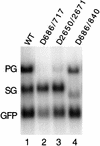
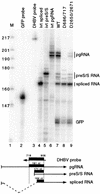

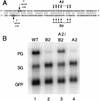
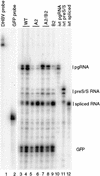
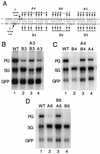
Similar articles
-
Hepatitis B virus replication.World J Gastroenterol. 2007 Jan 7;13(1):48-64. doi: 10.3748/wjg.v13.i1.48. World J Gastroenterol. 2007. PMID: 17206754 Free PMC article. Review.
-
Chimeras of duck and heron hepatitis B viruses provide evidence for functional interactions between viral components of pregenomic RNA encapsidation.J Virol. 2004 Aug;78(16):8780-7. doi: 10.1128/JVI.78.16.8780-8787.2004. J Virol. 2004. PMID: 15280486 Free PMC article.
-
A splice hepadnavirus RNA that is essential for virus replication.EMBO J. 1996 May 15;15(10):2565-74. EMBO J. 1996. PMID: 8665864 Free PMC article.
-
cis-acting sequences required for encapsidation of duck hepatitis B virus pregenomic RNA.J Virol. 1991 Jun;65(6):3309-16. doi: 10.1128/JVI.65.6.3309-3316.1991. J Virol. 1991. PMID: 2033673 Free PMC article.
-
RNA trans-splicing.Genet Eng (N Y). 1992;14:211-29. doi: 10.1007/978-1-4615-3424-2_12. Genet Eng (N Y). 1992. PMID: 1377925 Review. No abstract available.
Cited by
-
Hepatitis B virus replication.World J Gastroenterol. 2007 Jan 7;13(1):48-64. doi: 10.3748/wjg.v13.i1.48. World J Gastroenterol. 2007. PMID: 17206754 Free PMC article. Review.
-
GC content around splice sites affects splicing through pre-mRNA secondary structures.BMC Genomics. 2011 Jan 31;12:90. doi: 10.1186/1471-2164-12-90. BMC Genomics. 2011. PMID: 21281513 Free PMC article.
-
Solution structure of stem-loop alpha of the hepatitis B virus post-transcriptional regulatory element.Nucleic Acids Res. 2008 Mar;36(5):1681-9. doi: 10.1093/nar/gkn006. Epub 2008 Feb 7. Nucleic Acids Res. 2008. PMID: 18263618 Free PMC article.
-
The secondary structure of the human immunodeficiency virus type 1 transcript modulates viral splicing and infectivity.J Virol. 2008 Aug;82(16):8038-50. doi: 10.1128/JVI.00721-08. Epub 2008 Jun 11. J Virol. 2008. PMID: 18550660 Free PMC article.
-
Role of RNA structure in regulating pre-mRNA splicing.Trends Biochem Sci. 2010 Mar;35(3):169-78. doi: 10.1016/j.tibs.2009.10.004. Epub 2009 Dec 1. Trends Biochem Sci. 2010. PMID: 19959365 Free PMC article. Review.
References
-
- Boris-Lawrie, K., T. M. Roberts, and S. Hull. 2001. Retroviral RNA elements integrate components of post-transcriptional gene expression. Life Sci. 69:2697-2709. - PubMed
-
- Buscher, M., W. Reiser, H. Will, and H. Schaller. 1985. Transcripts and the putative RNA pregenome of duck hepatitis B virus: implications for reverse transcription. Cell 40:717-724. - PubMed
-
- Chang, C., R. C. Hirsch, and D. Ganem. 1995. Sequences in the preC region of duck hepatitis B virus affect pregenomic RNA accumulation. Virology 207:549-554. - PubMed
Publication types
MeSH terms
Substances
Grants and funding
LinkOut - more resources
Full Text Sources

